Chapter 9 Notes - Lifespan development
1/52
There's no tags or description
Looks like no tags are added yet.
Name | Mastery | Learn | Test | Matching | Spaced |
|---|
No study sessions yet.
53 Terms
Physical development
involves growth and changes in the body and brain, the senses, motor skills, and health and wellness
Cognitive development
involves learning, attention, memory, language, thinking, reasoning, and creativity
Psychosocial development
involves emotions, personality, and social relationships
Normative approach to development
“What is normal development?”
early decades of the 20th century, normative psychologists studied large numbers of children at various ages to determine norms of when most children reach specific developmental milestones in each of the three domains - physical, cognitive, and psychosocial
We use these age-related averages as general guidelines to compare children with same-age peers to determine the approximate ages they should reach specific normative events called developmental milestones
Ex: crawling, walking, writing, dressing, naming colors, speaking in sentences, and starting puberty
Not all normative events are universal, meaning they are not experienced by all individuals across all cultures.
Biological milestones, such as puberty, tend to be universal, but social milestones, such as the age when children begin formal schooling, are not necessarily universal
Continuous development
views development as a cumulative process, gradually improving on existing skills
gradual change
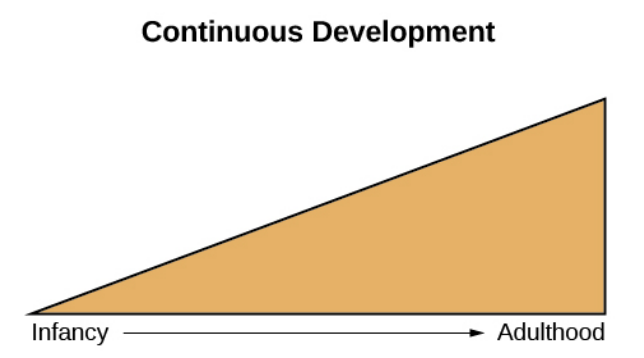
Discontinuous development
development takes place in unique stages: It occurs at specific times or ages
With this type of development, the change is more sudden, such as an infant’s ability to conceive object permanence

Stage theories
sequence of development is universal
Ex: children from around the world reach language milestones in a similar sequence
Infants in all cultures coo before they babble. They begin babbling at about the same age and utter their first word around 12 months old
Yet we live in diverse contexts that have a unique effect on each of us
Ex: Aché and walking
Genes and environment interaction
Our unique experiences in our environment influence whether and how particular traits are expressed, and at the same time, our genes influence how we interact with our environment
SES effect on development
Children from low-income households perform significantly more poorly than their middle- and high-income peers on a number of educational variables
Researchers found that middle- and high-income parents talk to their children significantly more, starting when the children are infants. By 3 years old, high-income children knew almost double the number of words known by their low-income counterparts, and they had heard an estimated total of 30 million more words than the low income counterpart
Psychosexual development - Freud
Sigmund Freud (1856–1939) believed that personality develops during early childhood
For Freud, childhood experiences shape our personalities and behavior as adults and that DEVELOPMENT = DISCONTINUOUS
He believed that each of us must pass through a series of stages during childhood, and that if we lack proper nurturance and parenting during a stage, we may become stuck, or fixated, in that stage
t. According to Freud, children’s pleasure-seeking urges are focused on a different area of the body, called an erogenous zone, at each of the five stages of development: oral, anal, phallic, latency, and genital
Psychosocial development - Erikson
Erik Erikson - modified Freud’s psychosexual theory
Emphasizes the social nature of our development rather than its sexual nature
While Freud believed that personality is shaped only in childhood, Erikson proposed that personality development takes place all through the lifespan
Ego identity - how we interact with others is what affects our sense of self
Erikson proposed that we are motivated by a need to achieve competence in certain areas of our lives
We experience eight stages of development over our lifespan, from infancy through late adulthood. At each stage there is a conflict, or task, that we need to resolve. Successful completion of each developmental task results in a sense of competence and a healthy personality. Failure to master these tasks leads to feelings of inadequacy.
Psychosocial development - Stage 1
birth to 12 months - primary task of this stage is trust versus mistrust
Unresponsive caregivers who do not meet their baby’s needs can engender feelings of anxiety, fear, and mistrust; their baby may see the world as unpredictable
Psychosocial development - Stage 2
ages 1–3 years
A toddler’s main task is to resolve the issue of autonomy versus shame and doubt, by working to establish independence. This is the “me do it” stage
Psychosocial development - Stage 3
ages 3–6 years
preschool children must resolve the task of initiative versus guilt
By learning to plan and achieve goals while interacting with others, preschool children can master this task
Those who do will develop self-confidence and feel a sense of purpose. Those who are unsuccessful at this stage—with their initiative misfiring or stifled—may develop feelings of guilt
Psychosocial development - Stage 4
ages 7–11
children face the task of industry versus inferiority
Children begin to compare themselves to their peers to see how they measure up. They either develop a sense of pride and accomplishment in their schoolwork, sports, social activities, and family life, or they feel inferior and inadequate when they don’t measure up
Psychosocial development - Stage 5
ages 12–18
children face the task of identity versus role confusion
According to Erikson, an adolescent’s main task is developing a sense of self
Adolescents who are successful at this stage have a strong sense of identity and are able to remain true to their beliefs and values in the face of problems and other people’s perspectives
Psychosocial development - Stage 6
20s through early 40s
concerned with intimacy versus isolation
Erikson said that we must have a strong sense of self before developing intimate relationships with others. Adults who do not develop a positive self-concept in adolescence may experience feelings of loneliness and emotional isolation.
Psychosocial development - Stage 7
When people reach their 40s, they enter the time known as middle adulthood, which extends to the mid-60s
generativity versus stagnation
Generativity involves finding your life’s work and contributing to the development of others, through activities such as volunteering, mentoring, and raising children
Those who do not master this task may experience stagnation, having little connection with others and little interest in productivity and self-improvement
Psychosocial development - Stage 7
mid-60s to the end of life, late adulthood
people in late adulthood reflect on their lives and feel either a sense of satisfaction or a sense of failure
People who feel proud of their accomplishments feel a sense of integrity, and they can look back on their lives with few regrets.
However, people who are not successful at this stage may feel as if their life has been wasted. They focus on what “would have,” “should have,” and “could have” been. They face the end of their lives with feelings of bitterness, depression, and despair.
Erikson’s Psychosocial Stages of Development summary table
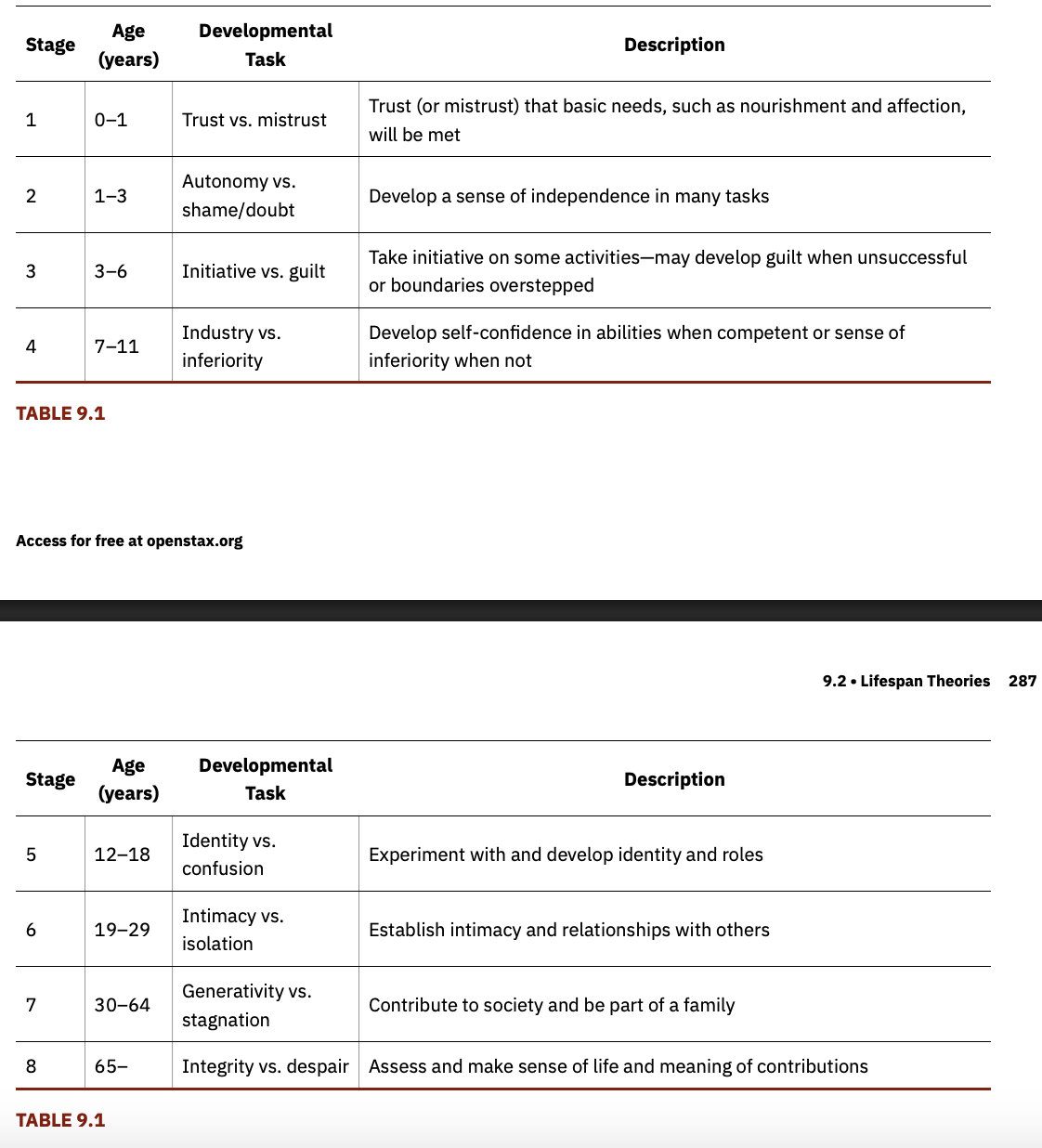
Jean Piaget
stage theorist who studied childhood development
Piaget focused on children’s cognitive growth
believed that thinking is a central aspect of development and that children are naturally inquisitive. However, he said that children do not think and reason like adult
His theory of cognitive development holds that our cognitive abilities develop through specific stages, which exemplifies the discontinuity approach to development. As we progress to a new stage, there is a distinct shift in how we think and reason
Piaget said that children develop schemata to help them understand the world
Piaget thought development unfolds in a series of stages approximately associated with age ranges. He proposed a theory of cognitive development that unfolds in four stages: sensorimotor, preoperational, concrete operational, and formal operational
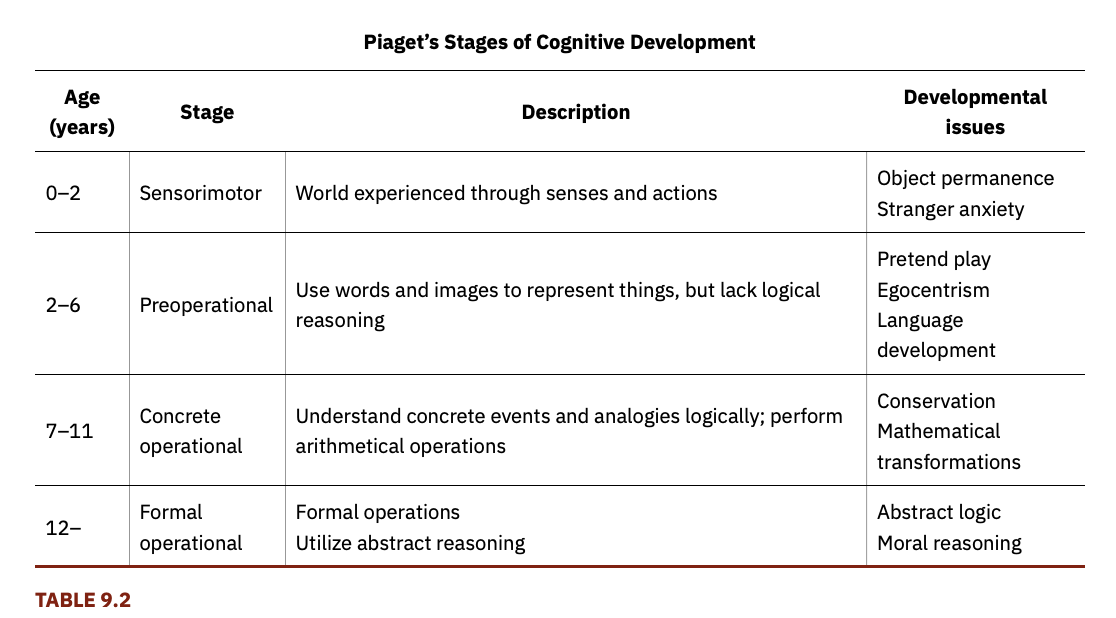
Schemata (Piaget)
Schemata are concepts (mental models) that are used to help us categorize and interpret information
By the time children have reached adulthood, they have created schemata for almost everything
Assimilation and accommodation
When children learn new information, they adjust their schemata through two processes: assimilation and accommodation
First, they assimilate new information or experiences in terms of their current schemata: assimilation is when they take in information that is comparable to what they already know.
Accommodation describes when they change their schemata based on new information. This process continues as children interact with their environment.
Piaget’s Stages of Cognitive Development: 1. sensorimotor
lasts from birth to about 2 years old
children learn about the world through their senses and motor behavior
Between 5 and 8 months old, the child develops object permanence, which is the understanding that even if something is out of sight, it still exists
According to Piaget, young infants do not remember an object after it has been removed from sight
around the same time children develop object permanence, they also begin to exhibit stranger anxiety, which is a fear of unfamiliar people.
Stranger anxiety results when a child is unable to assimilate the stranger into an existing schema
Piaget’s Stages of Cognitive Development: 2. e preoperational stage
2 to 7 years old
children can use symbols to represent words, images, and ideas, which is why children in this stage engage in pretend play
use language in the preoperational stage, but they cannot understand adult logic or mentally manipulate information
Children in this stage cannot perform mental operations because they have not developed an understanding of conservation, which is the idea that even if you change the appearance of something, it is still equal in size as long as nothing has been removed or added
also expect children to display egocentrism, which means that the child is not able to take the perspective of others
Piaget’s Stages of Cognitive Development: 3. concrete operational stage
7 to 11 years old
children can think logically about real (concrete) events; they have a firm grasp on the use of numbers and start to employ memory strategies
also understand the principle of reversibility, which means that objects can be changed and then returned back to their original form or condition
Piaget’s Stages of Cognitive Development: 4. formal operational stage
age 11 to adulthood
children in the formal operational stage can also deal with abstract ideas and hypothetical situations.
renewed egocentrism occurs. For example, a 15-year-old with a very small pimple on her face might think it is huge and incredibly visible, under the mistaken impression that others must share her perceptions.
Piaget’s ideas criticism
several contemporary studies support a model of development that is more continuous than Piaget’s discrete stages
Many others suggest that children reach cognitive milestones earlier than Piaget describes
According to Piaget, the highest level of cognitive development is formal operational thought, which develops between 11 and 20 years old. However, many developmental psychologists disagree with Piaget, suggesting a fifth stage of cognitive development, known as the postformal stage
decisions are made based on situations and circumstances, and logic is integrated with emotion as adults develop principles that depend on contexts
once we reach adulthood our problem solving abilities change: As we attempt to solve problems, we tend to think more deeply about many areas of our lives, such as relationships, work, and politics
neuroconstructivism
suggests that neural brain development influences cognitive development
Experiences that a child encounters can impact or change the way that neural pathways develop in response to the environment. An individual’s behavior is based on how one understands the world.
There is interaction between neural and cognitive networks at and between each level, consisting of these: • genes • neurons • brain • body • social environment
Lev Vygotsky - sociocultural theory of development
human development is rooted in one’s culture
The language one speaks and the ways a person thinks about things is dependent on one’s cultural background.
historical influences as key to one’s development
Lawrence Kohlberg - Moral Theory Of Development
Kohlberg believed that moral development, like cognitive development, follows a series of stages
After presenting people with this and various other moral dilemmas, Kohlberg reviewed people’s responses and placed them in different stages of moral reasoning
According to Kohlberg, an individual progresses from the capacity for pre-conventional morality (before age 9) to the capacity for conventional morality (early adolescence), and toward attaining post-conventional morality (once formal operational thought is attained), which only a few fully achieve
Kohlberg placed in the highest stage responses that reflected the reasoning that Heinz should steal the drug because his wife’s life is more important than the pharmacist making money. The value of a human life overrides the pharmacist’s greed.
Many psychologists agree with Kohlberg's theory of moral development but point out that moral reasoning is very different from moral behavior. Sometimes what we say we would do in a situation is not what we actually do in that situation. In other words, we might “talk the talk,” but not “walk the walk.”
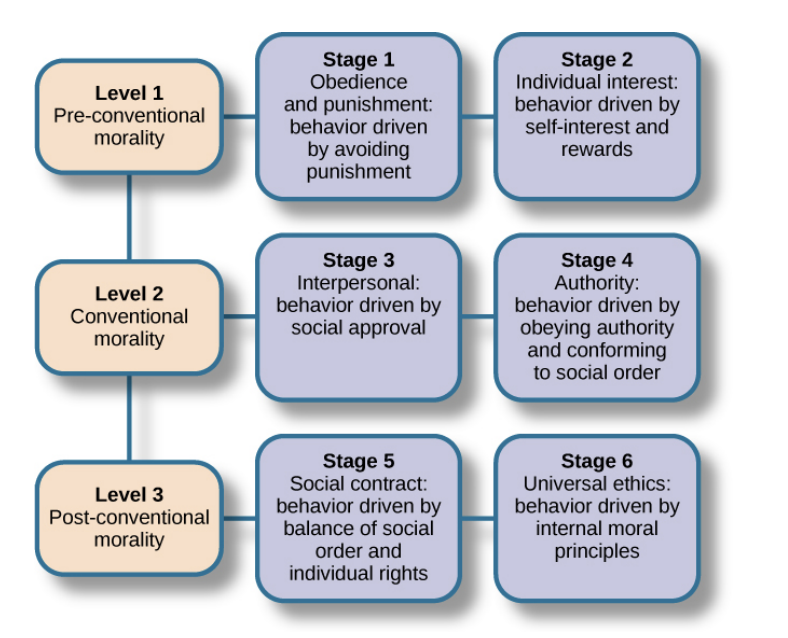
Kohlberg and Carol Gilligan
Kohlberg (1969) felt that more men than women move past stage four in their moral development. He went on to note that women seem to be deficient in their moral reasoning abilities.
These ideas were not well received by Carol Gilligan, a research assistant of Kohlberg, who consequently developed her own ideas of moral development. In her groundbreaking book, In a Different Voice: Psychological Theory and Women’s Development, Gilligan (1982) criticized her former mentor’s theory because it was based only on upper class White men and boys.
She argued that women are not deficient in their moral reasoning—she proposed that different genders reason differently. Girls and women focus more on staying connected and the importance of interpersonal relationships.
Three stages of prenatal development
germinal, embryonic, and fetal
Prenatal development: 1. Germinal Stage (Weeks 1–2)
DNA is passed on to the child at the moment of conception. Conception occurs when sperm fertilizes an egg and forms a zygote
A zygote begins as a one-cell structure that is created when a sperm and egg merge. The genetic makeup and sex of the zygote are set at this point.
During the first week after conception, the zygote divides and multiplies, going from a one-cell structure to two cells, then four cells, then eight cells, and so on. This process of cell division is called mitosis.
Mitosis is a fragile process, and fewer than one-half of all zygotes survive beyond the first two weeks (Hall, 2004). After 5 days of mitosis there are 100 cells, and after 9 months there are billions of cells.
As the cells divide, they become more specialized, forming different organs and body parts. In the germinal stage, the mass of cells has yet to attach itself to the lining of the mother’s uterus. Once it does, the next stage begins.
Prenatal development: 2. Embryonic Stage (Weeks 3–8)
After the zygote divides for about 7–10 days and has 150 cells, it travels down the fallopian tubes and implants itself in the lining of the uterus.
Upon implantation, this multi-cellular organism is called an embryo. Now blood vessels grow, forming the placenta.
The placenta is a structure connected to the uterus that provides nourishment and oxygen from the mother to the developing embryo via the umbilical cord. Basic structures of the embryo start to develop into areas that will become the head, chest, and abdomen.
During the embryonic stage, the heart begins to beat and organs form and begin to function. The neural tube forms along the back of the embryo, developing into the spinal cord and brain
Prenatal development: 3. Fetal Stage (Weeks 9–40)
When the organism is about nine weeks old, the embryo is called a fetus. At this stage, the fetus is about the size of a kidney bean and begins to take on the recognizable form of a human being as the “tail” begins to disappear.
From 9–12 weeks, the sex organs begin to differentiate.
At about 16 weeks, the fetus is approximately 4.5 inches long. Fingers and toes are fully developed, and fingerprints are visible.
By the time the fetus reaches the sixth month of development (24 weeks), it weighs up to 1.4 pounds. Hearing has developed, so the fetus can respond to sounds. The internal organs, such as the lungs, heart, stomach, and intestines, have formed enough that a fetus born prematurely at this point has a chance to survive outside of the mother’s womb.
Throughout the fetal stage the brain continues to grow and develop, nearly doubling in size from weeks 16 to 28.
Around 36 weeks, the fetus is almost ready for birth. It weighs about 6 pounds and is about 18.5 inches long, and by week 37 all of the fetus’s organ systems are developed enough that it could survive outside the uterus without many of the risks associated with premature birth.
The fetus continues to gain weight and grow in length until approximately 40 weeks. By then, the fetus has very little room to move around and birth becomes imminent

Prenatal care
medical care during pregnancy that monitors the health of both the mother and the fetus
reduce the risk of complications to the mother and fetus during pregnancy
Teratogen
Anything the mother is exposed to in the environment affects the fetus; if the mother is exposed to something harmful, the child can show life-long effects.
Any environmental agent—biological, chemical, or physical—that causes damage to the developing embryo or fetus
Alcohol - fetal alcohol spectrum disorders with life-long consequences for the child ranging in severity from minor to major
FASD - a collection of birth defects associated with heavy consumption of alcohol during pregnancy
Physically, children with FASD may have a small head size and abnormal facial features. Cognitively, these children may have poor judgment, poor impulse control, higher rates of ADHD, learning issues, and lower IQ scores.
it also has been suggested that a parent's alcohol consumption during pregnancy may predispose their child to like alcohol
Smoking - nicotine travels through the placenta to the fetus.
developing baby experiences a reduction in blood oxygen levels
smoking while pregnant can result in premature birth, low-birthweight infants, stillbirth, and sudden infant death syndrome (SIDS)
Heroin, cocaine, methamphetamine, almost all prescription medicines, and most over-the counter medications are also considered teratogens
Babies born with a heroin addiction need heroin just like an adult addict. The child will need to be gradually weaned from the heroin under medical supervision; otherwise, the child could have seizures and die.
Other teratogens include radiation, viruses such as HIV and herpes, and rubella (German measles)
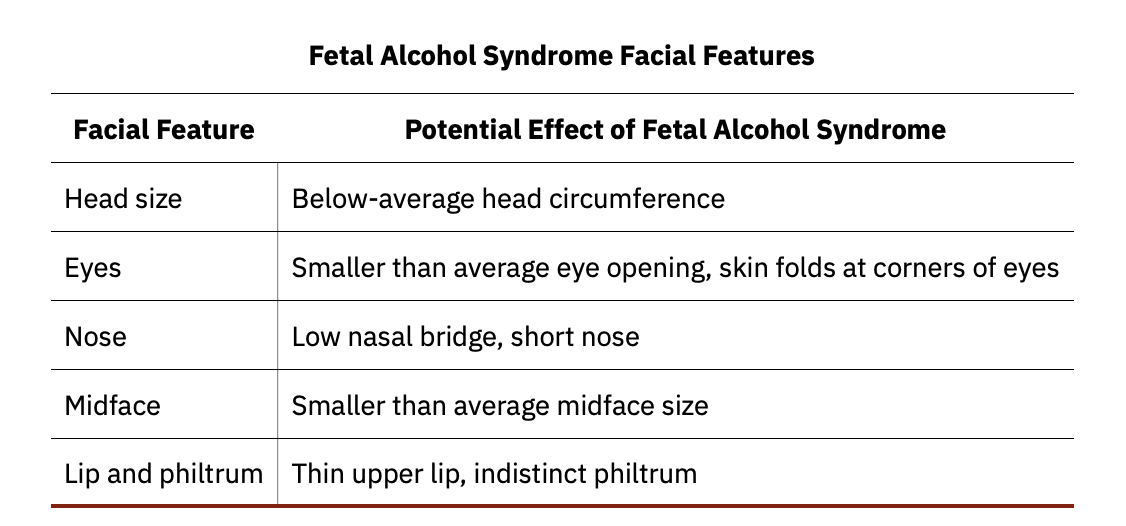
Critical or sensitive period
Each organ of the fetus develops during a specific period in the pregnancy, called the critical or sensitive period
the time during which a developing fetus is exposed to alcohol can dramatically affect the appearance of facial characteristics associated with fetal alcohol syndrome
research suggests that alcohol exposure that is limited to day 19 or 20 of gestation can lead to significant facial abnormalities in the offspring
Newborn reflexes
All healthy babies are born with newborn reflexes: inborn automatic responses to particular forms of stimulation. Reflexes help the newborn survive until it is capable of more complex behaviors—these reflexes are crucial to survival
usually disappear around 4–5 months old
Moro reflex is the newborn’s response to the sensation of falling